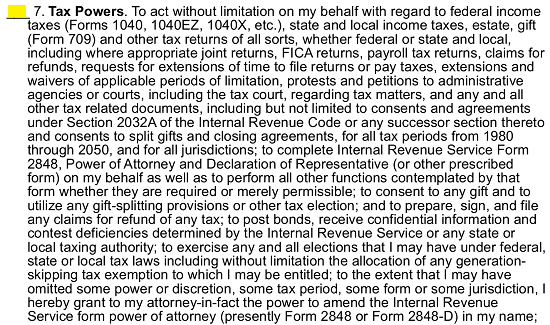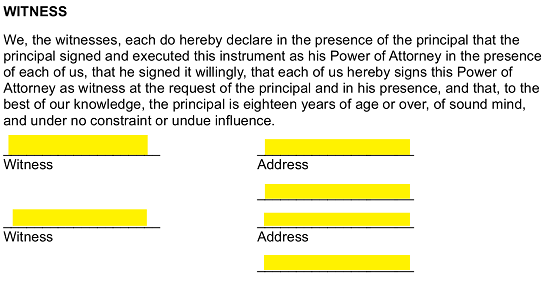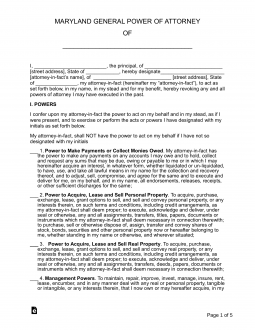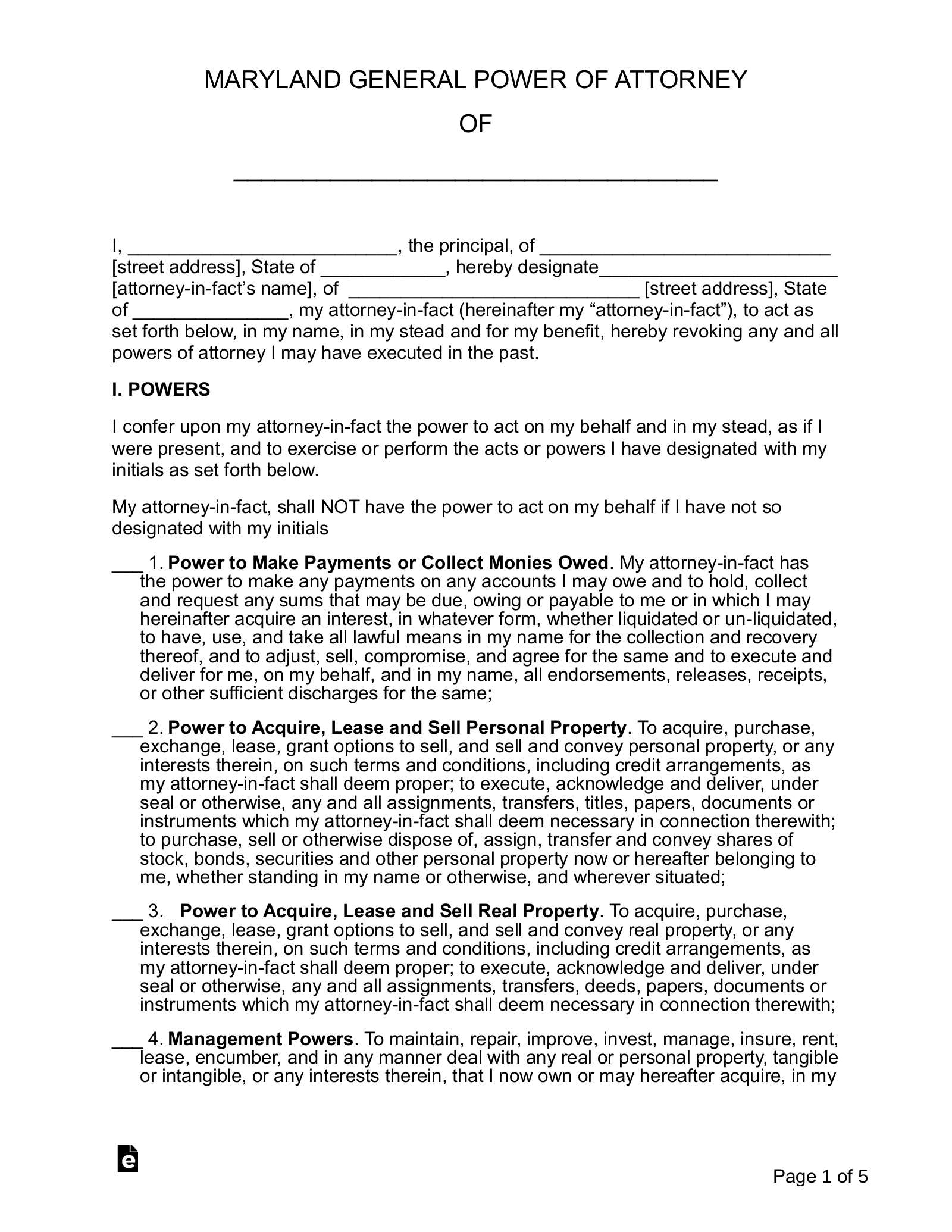Updated October 04, 2023
A Maryland general (financial) power of attorney form is a document required to convey certain financial powers to another trusted person. That person, or agent, is tasked with representing your (the principal’s) best interests and acting on your behalf up until you revoke the document or become unable to revoke the document. This is different from the durable form, in that it becomes void upon your incapacity. If you are planning for potential incapacity, you should not use this form. You should use the durable form instead.
Laws
- Statutes – Maryland General and Limited Power of Attorney Act (§§ 17-101 — 17-203)
- Authority (MD Code, Estates and Trusts, § 17-202) – An agent under a personal financial power of attorney may act on behalf of the principal and exercise broad authority as granted by the agreement.
- Signing Requirements (MD Code, Estates and Trusts, § 17-110 & MD Code, Estates and Trusts, § 17-202) – Two (2) Witnesses and Notary Public.
How to Write
Download: PDF, MS Word, OpenDocument
1 – The Grantor And Attorney-in-Fact’s Identity And Location Must Be Supplied
For this document to be truly effective a Principal statement must be made declaring the intent of granting Power to the Attorney-in-Fact. This statement is presented as the introduction of this template.
Enter the Grantor’s First Name, Middle Initial, and Last Name on the first blank line. On the following two blank lines, record the Grantor’s Residential Street Address then his or her State of Residence.  In a similar fashion, after the words “hereby designate,” the same information regarding the Agent or Attorney-in-Fact must be filled in. Use the three blank spaces after this term to report the Attorney-in-Fact’s Full Legal Name, then his or her Residential Street Address and which State this Address is located in.
In a similar fashion, after the words “hereby designate,” the same information regarding the Agent or Attorney-in-Fact must be filled in. Use the three blank spaces after this term to report the Attorney-in-Fact’s Full Legal Name, then his or her Residential Street Address and which State this Address is located in.
2 – Attend To The List Of Authority Items Displayed
A list of numbered items will be presented under the heading, “I. Powers.” Each Power here will provide a description of what the Attorney-in-Fact acting with Principal Power may do with the Approval of the Principal or Grantor of Power. Any item on this list that contains a description of what the Principal wishes or intends the Attorney-in-Fact to do will need to be initialed by the Principal so that it will be applied to the definition of the Principal Approved Authority the Attorney-in-Fact gains because of this form’s completion.
Statement number one will deliver the necessary wording to deliver the Attorney-in-Fact with the Principal Authority to make Payments on behalf of the Principal or Collect Money in his or her name if it is initialed by the Principal or Grantor.  The next statement will describe the Principal Power appointed to the Attorney-in-Fact that empowers him or her to acquire Personal Property on behalf of the Principal, sell the Principal’s Personal Property, lease the Principal’s Personal Property and engage in the activities defined. The Principal will need to initial the blank space preceding the number two to designate such Power to the Attorney-in-Fact.
The next statement will describe the Principal Power appointed to the Attorney-in-Fact that empowers him or her to acquire Personal Property on behalf of the Principal, sell the Principal’s Personal Property, lease the Principal’s Personal Property and engage in the activities defined. The Principal will need to initial the blank space preceding the number two to designate such Power to the Attorney-in-Fact.  The third paragraph shall describe the Principal “Power to Acquire, Lease, or Sell Real Property.” Any action defined here will be approved by the Principal once, he or she initials the blank space.
The third paragraph shall describe the Principal “Power to Acquire, Lease, or Sell Real Property.” Any action defined here will be approved by the Principal once, he or she initials the blank space.  The “Management Powers” the Principal may appoint to an Attorney-in-Fact will be discussed in the fourth item. If the Principal initials this passage, he or she will grant all the Powers defined in this paragraph.
The “Management Powers” the Principal may appoint to an Attorney-in-Fact will be discussed in the fourth item. If the Principal initials this passage, he or she will grant all the Powers defined in this paragraph.  The fifth statement will grant the Principal’s “Banking Powers” to the Attorney-in-Fact, once the Principal initials the blank space provided.
The fifth statement will grant the Principal’s “Banking Powers” to the Attorney-in-Fact, once the Principal initials the blank space provided.  If the Grantor initials the “Motor Vehicles” paragraph, he or she will empower the Attorney-in-Fact to act with Principal Powers in relation to Motor Vehicles.
If the Grantor initials the “Motor Vehicles” paragraph, he or she will empower the Attorney-in-Fact to act with Principal Powers in relation to Motor Vehicles.  The Attorney-in-Fact will have the Principal Authority required to act on the Principal’s behalf with Principal “Taxes,” if the Principal initials the seventh item.
The Attorney-in-Fact will have the Principal Authority required to act on the Principal’s behalf with Principal “Taxes,” if the Principal initials the seventh item.  The Attorney-in-Fact will be able to access and control the Safe-Deposit Boxes of the Principal as if he or she were the Principal if the Principal initials the blank space in the eighth item.
The Attorney-in-Fact will be able to access and control the Safe-Deposit Boxes of the Principal as if he or she were the Principal if the Principal initials the blank space in the eighth item.  The “Gift Making Powers” of the Principal will be granted to the Attorney-in-Fact in the manner defined in item nine, once the Principal initials the empty line preceding the number nine.
The “Gift Making Powers” of the Principal will be granted to the Attorney-in-Fact in the manner defined in item nine, once the Principal initials the empty line preceding the number nine.  The same “Lending and Borrowing” Powers the Grantor has will be appointed to the Attorney-in-Fact by virtue of the tenth statement if the Principal initials the blank space in this statement.
The same “Lending and Borrowing” Powers the Grantor has will be appointed to the Attorney-in-Fact by virtue of the tenth statement if the Principal initials the blank space in this statement.  The Principal’s “Contracts” will be under the effect of the Attorney-in-Fact’s Principal Powers if the Principal initials the eleventh statement.
The Principal’s “Contracts” will be under the effect of the Attorney-in-Fact’s Principal Powers if the Principal initials the eleventh statement. ![]() If the Principal initials the twelfth item, he or she will give the Attorney-in-Fact the right to make decisions regarding the “Health Care” of the Principal”
If the Principal initials the twelfth item, he or she will give the Attorney-in-Fact the right to make decisions regarding the “Health Care” of the Principal” The Principal will name the Attorney-in-Fact as his or her personal representative as per the Health Insurance Portability and Accountability Act of 1996″
The Principal will name the Attorney-in-Fact as his or her personal representative as per the Health Insurance Portability and Accountability Act of 1996″![]() The “Power to Hire and Pay for Services” statement uses the required language to grant the Attorney-in-Fact with the Principal Power to gain, negotiate, manage, and terminate Professional Services on behalf of the Principal, if the Principal initials this statement.
The “Power to Hire and Pay for Services” statement uses the required language to grant the Attorney-in-Fact with the Principal Power to gain, negotiate, manage, and terminate Professional Services on behalf of the Principal, if the Principal initials this statement.  The Attorney-in-Fact may seek Reimbursement for his or her services using Principal Powers and Authority, once the Principal initials the fifteenth item.
The Attorney-in-Fact may seek Reimbursement for his or her services using Principal Powers and Authority, once the Principal initials the fifteenth item. ![]() The Attorney-in-Fact will have the Principal “Power to Sue Third Parties Who Fail To Act Pursuant to Power of Attorney” if the Grantor initials the blank space preceding the number sixteen.
The Attorney-in-Fact will have the Principal “Power to Sue Third Parties Who Fail To Act Pursuant to Power of Attorney” if the Grantor initials the blank space preceding the number sixteen.  The seventeenth statement will provide a venue for the Principal to directly name any additions or restrictions that should be applied to the Attorney-in-Fact’s Principal Powers. If this option is utilized, the Principal must initial the seventeenth item, then use the blank lines to deliver his or her provisions and/or instructions.
The seventeenth statement will provide a venue for the Principal to directly name any additions or restrictions that should be applied to the Attorney-in-Fact’s Principal Powers. If this option is utilized, the Principal must initial the seventeenth item, then use the blank lines to deliver his or her provisions and/or instructions.
3 – Declare The Determined Period Of Effect
The next section requiring information, under the heading “III. Effective Date And Termination,” allows the Principal’s Preferences to when the Attorney-in-Fact’s Principal Powers begin and when the Attorney-in-Fact’s Principal Powers are no longer approved. Note: You may only initial one statement for the Start of the Period of Effect and one statement for the Termination of the Period of Effect. The Attorney-in-Fact’s Principal Powers may become effective as of the Principal’s Signature Date if the Principal initials the first statement.![]() If the Principal initials the second statement, the Attorney-in-Fact’s Principal Powers will only become Effective as of a specific date. If choosing this option, make sure to use the blank space provided after the word “date” to indicate the first day the Attorney-in-Fact may use Principal Powers.
If the Principal initials the second statement, the Attorney-in-Fact’s Principal Powers will only become Effective as of a specific date. If choosing this option, make sure to use the blank space provided after the word “date” to indicate the first day the Attorney-in-Fact may use Principal Powers.![]()
Next, one of three choices must be initialed to indicate when the Attorney-in-Fact is no longer allowed, Principal Powers. It is worth noting the Principal always reserves the right to issue a Revocation, regardless of his or her preferences here. If the Principal prefers a specific Termination Date, then he or she should initial the first blank space below the statement in parentheses (“…termination is effective at which of the following occurs first”), then enter the exact Date of Termination in the spaces provided.![]()
If the Principal prefers this document terminates only upon a written revocation, then initial the second blank space in this area.![]() The Principal may initial the third blank space, if he or she prefers this document’s Termination be contingent upon being declared incapacitated by a physician.
The Principal may initial the third blank space, if he or she prefers this document’s Termination be contingent upon being declared incapacitated by a physician.![]()
4 – The Grantor of Power, Attorney-in-Fact, Signature Witnesses, And Notary Public Must Verify This Form
The final several areas of this form will require several signatures. The first must be that of the Principal who is granting Power. The Principal will need to enter the Date he or she is signing using the blank spaces in the last sentence (“In Witness Whereof”). ![]() When the task is completed the Principal will need to sign and print his or her Name on the empty lines below the words “Principal’s Signature” and “Principal’s Printed Name”
When the task is completed the Principal will need to sign and print his or her Name on the empty lines below the words “Principal’s Signature” and “Principal’s Printed Name” The next party who must tend to this document is the Attorney-in-Fact. Here, under the heading “Acceptance of Appointment,” the Attorney-in-Fact will need to supply his or her printed name on the blank space in the Acceptance Statement. Below this statement, the Attorney-in-Fact must sign and print the two blank spaces: “Attorney-in-Fact’s Signature,” and “Attorney-in-Fact’s Printed Name.”
The next party who must tend to this document is the Attorney-in-Fact. Here, under the heading “Acceptance of Appointment,” the Attorney-in-Fact will need to supply his or her printed name on the blank space in the Acceptance Statement. Below this statement, the Attorney-in-Fact must sign and print the two blank spaces: “Attorney-in-Fact’s Signature,” and “Attorney-in-Fact’s Printed Name.” Next, each of the two Witnesses observing the Principal signing should read the “Witness” statement, then provide his or her Signature and Address on the blank lines provided.
Next, each of the two Witnesses observing the Principal signing should read the “Witness” statement, then provide his or her Signature and Address on the blank lines provided.  The “Acknowledgment of Notary Public” will allow the serving Notary Public to provide the Notarization process in a defined and structured area. Follow any directions this entity gives you so that he or she may Notarize this signing properly.
The “Acknowledgment of Notary Public” will allow the serving Notary Public to provide the Notarization process in a defined and structured area. Follow any directions this entity gives you so that he or she may Notarize this signing properly.


